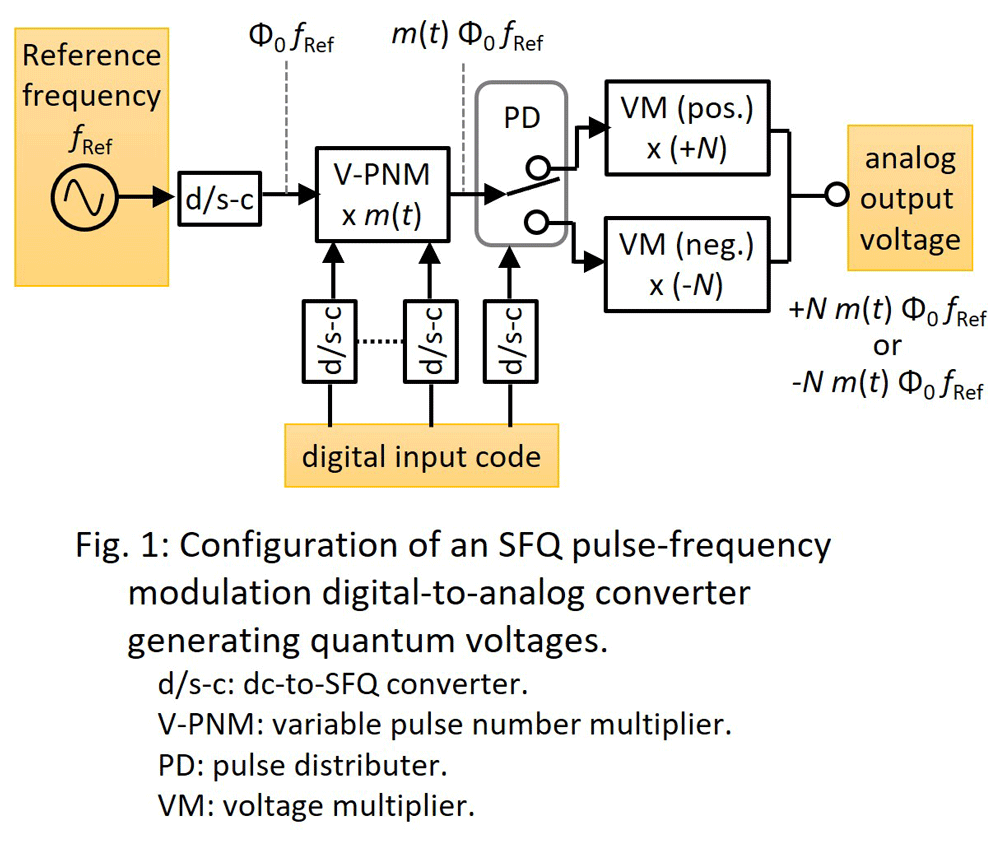ED-8-1-INV
Development of RSFQ digital-to-analog converters generating quantum voltages
12:30-13:00 30/11/2023
*Yoshinao Mizugaki
The University of Electro-Communications (UEC Tokyo) 1-5-1 Chofugaoka, Chofu, Tokyo 182-8585, Japan
When the phase difference of a Josephson junction is synchronized with microwave of frequency f, quantum voltage of n Φ0 f appears across the junction, where n and Φ0 are an integer and the quantity of a single flux quantum (SFQ). In the same way, when an SFQ pulse train of the repetition frequency f is transferred in a network of Josephson junctions, quantum voltage of n Φ0 f appears across Josephson junctions. That is the fundamental concept of RSFQ digital-to-analog converters (DACs) generating quantum voltages [1]. Since 1990's, various types of RSFQ DACs have been proposed and demonstrated.
My research group has developed RSFQ DACs of SFQ pulse-frequency modulation (PFM), where the SFQ pulse repetition frequency is modulated to generate various values of quantum voltages. A simplified configuration of our SFQ-PFM DAC is shown in Fig. 1. It is composed of a variable pulse number multiplier (V-PNM), a pulse distributer (PD), and voltage multipliers (VMs). A reference microwave signal of frequency fRef is converted to an SFQ pulse train of the repetition frequency fRef at the dc-to-SFQ converter (d/s-c) placed between the reference microwave source and the V-PNM. Each SFQ pulse is multiplied by m(t) at the V-PNM, where the multiplication factor m(t) is determined by the digital input code. Then, the voltage becomes m(t) Φ0 fRef. The multiplied SFQ pulse train is forwarded to the positive or negative VM according to the digital input code. At the VM, the voltage of m(t) Φ0 fRef is multiplied to either +N m(t) N m(t)Φ;0 fRef or -N m(t)Φ;0 fRef, where +N and -N are the multiplication factors of the positive and negative VM, respectively.
So far, we have designed and operated circuit components and whole SFQ-PFM DACs fabricated using Nb/AlOx/Nb integration technologies. The highest resolution of our SFQ-PFM DACs was realized by a 9-bit DAC that generating unipolar output voltage up to 2.5 mV [2]. A bipolar SFQ-PFM DAC was demonstrated with output voltage of ±0.29 mV [3]. We also operated a stand-alone 1000-fold VM generating unipolar voltage up to 43 mV [4]. In addition, we also demonstrated sinusoidal voltage waveform synthesizers comprising an SFQ-PFM DAC and a code generator, both of which were integrated on the same chip [5,6].
[1] C.A. Hamilton: “Josephson voltage standard based on single-flux-quantum voltage multiplier,” IEEE Trans. Appl. Supercond. 2 (1992) 139-142
[2] Y. Mizugaki, Y. Takahashi, H. Shimada, and M. Maezawa: “9-bit superconductive single-flux-quantum digital-to-analogue converter,” Electronics Lett. 50 (2014) 1637–1639
[3] Y. Mizugaki, T. Watanabe, and H. Shimada: “Superconducting bipolar digital-to-analog converter equipped with dual double-flux-quantum amplifier,” IEICE Electronics Express 13 (2016) 20160242
[4] Y. Mizugaki, Y. Arai, T. Watanabe, and H. Shimada: “1000-Fold Double-Flux-Quantum Voltage Multiplier Employing Directional Propagation of Flux Quanta Through Asymmetrically Damped Junction Branches,” IEEE Trans. Appl. Supercond. 29 (2019) 1400105
[5] Y. Mizugaki, K. Kuroiwa, M. Moriya, H. Shimada, and M. Maezawa: “5-bit quasi-sinusoidal voltage waveform synthesized using single-flux-quantum pulse-frequency modulation,” IEEE Trans. Appl. Supercond. 23 (2013) 1300804
[6] Y. Takahashi, H. Shimada, M. Maezawa, and Y. Mizugaki: “Design and operation of 6-bit, 0.25-mVpp quasi-sine voltage waveform generator based on SFQ pulse-frequency modulation,” Physics Procedia 58 (2014) 220-223
This work was partly supported by JSPS KAKENHI 15760238, 17681018, 18080004, and 15K13999. This work was also supported through the activities of VDEC, The University of Tokyo, in collaboration with Cadence Design Systems. The author wishes to thank Masaaki Maezawa for collaboration on the early stages of this work.
